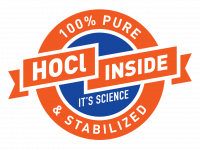HOCl As a Microbicidal Agent
Story At-A-Glance
- HOCl effectively kills many types of bacteria, viruses, and fungi.
- HOCl is non-toxic, non-irritating, and non-corrosive
An Overview
Scientific, medical, and professional journals list many peer-reviewed articles describing the efficacy of HOCl in killing pathogens. One medical dictionary describes a pathogen as an agent that causes disease, especially a virus, bacterium, or fungus1. Another medical dictionary describes a microbicide as an agent that kills microscopic organisms (bacteria, fungi, and viruses)2. These definitions – and the peer-reviewed literature – confirm that HOCl is an effective microbicidal agent against many types of bacteria, viruses, and fungi.
Attributes
Studies show HOCl to be an effective microbicidal agent while it also is non-toxic, non-irritating, and non-corrosive at proper usage concentrations3. HOCl also has other advantages over other microbicidal agents such as sodium hypochlorite (NaOCl) and hydrogen peroxide (H202). It causes less irritation, and is less cytotoxic, if used at proper concentrations. HOCl works best between pH levels of 3 to 6. HOCl efficacy is often affected by its shelf life4.
Research
Research on HOCl as a microbicidal agent is classified according to whether it’s used to combat bacteria, virus, or fungi. For bacteria, there are articles on Bacillus SPP, Campylobacter SPP, Enterobacter SPP, Enterococcus SPP, Escherichia Coli, Listeria SPP, Mycobacterium SPP, Pseudomonas SPP, Salmonella SPP, Staphylococcus SPP, Streptomyces SPP, and Vibrio SPP. For viruses, there are articles on Hepadnavirus, Hepatitis B, Hepatitis C, HIV, Influenza Viruses, all Viruses, Norovirus, and SARS-CoV-2. For fungi, there are articles on Aspergillus SPP, Candida SPP, Penicillium SPP, and all Fungi.
Future articles will feature each of these pathogens.
Sources and References
- 1 The American Heritage® Medical Dictionary Copyright © 2007, 2004 by Houghton Mifflin Company. Published by Houghton Mifflin Company.
- 2 Medical Dictionary, © 2009 Farlex and Partners
- 3, 4 Mujde Eryilmaz and Ismail Murat Palabiyik (2013) Hypochlorous Acid – Analytical Methods and Antimicrobial Activity. Tropical Journal of Pharmaceutical Research February 2013; 12 (1): 123-126
